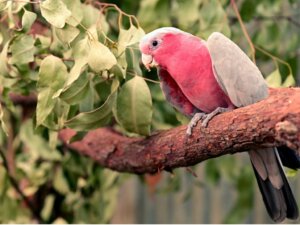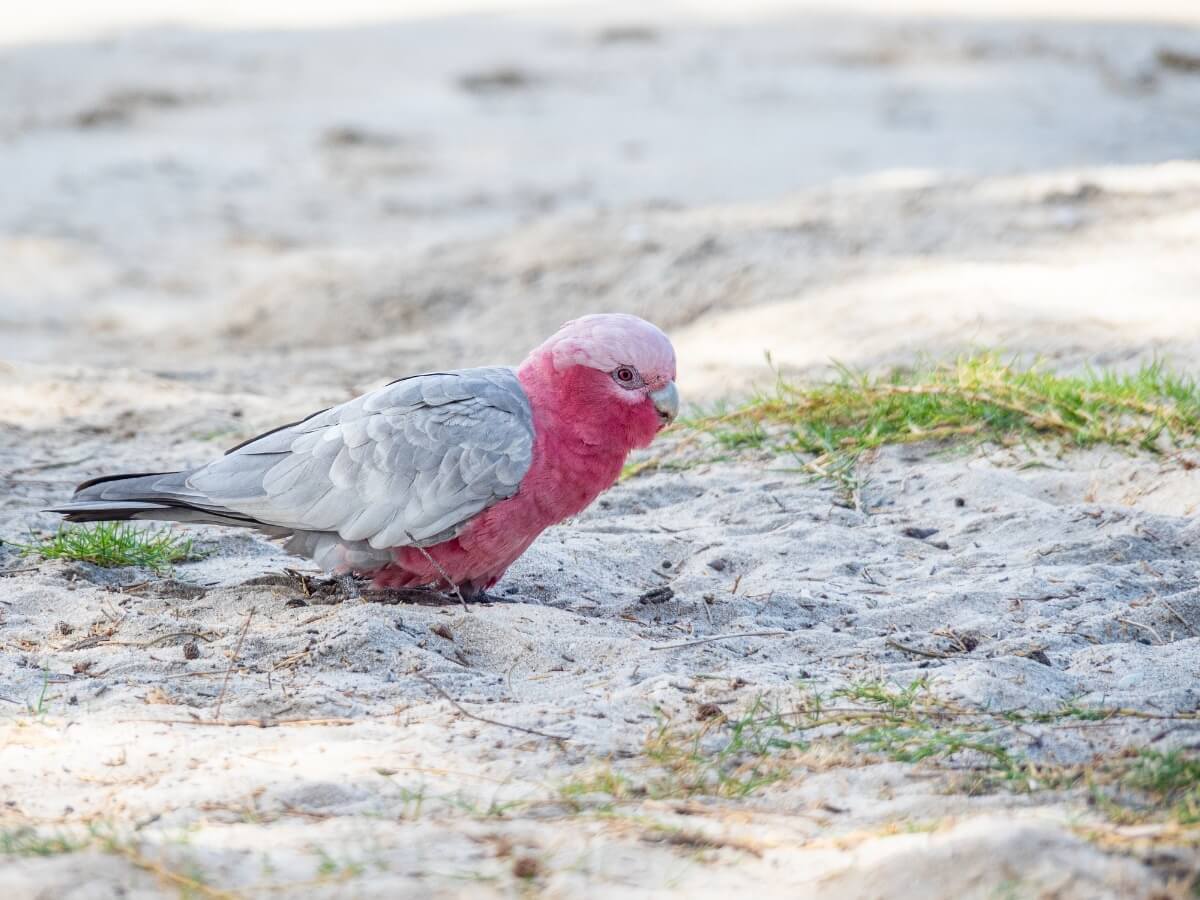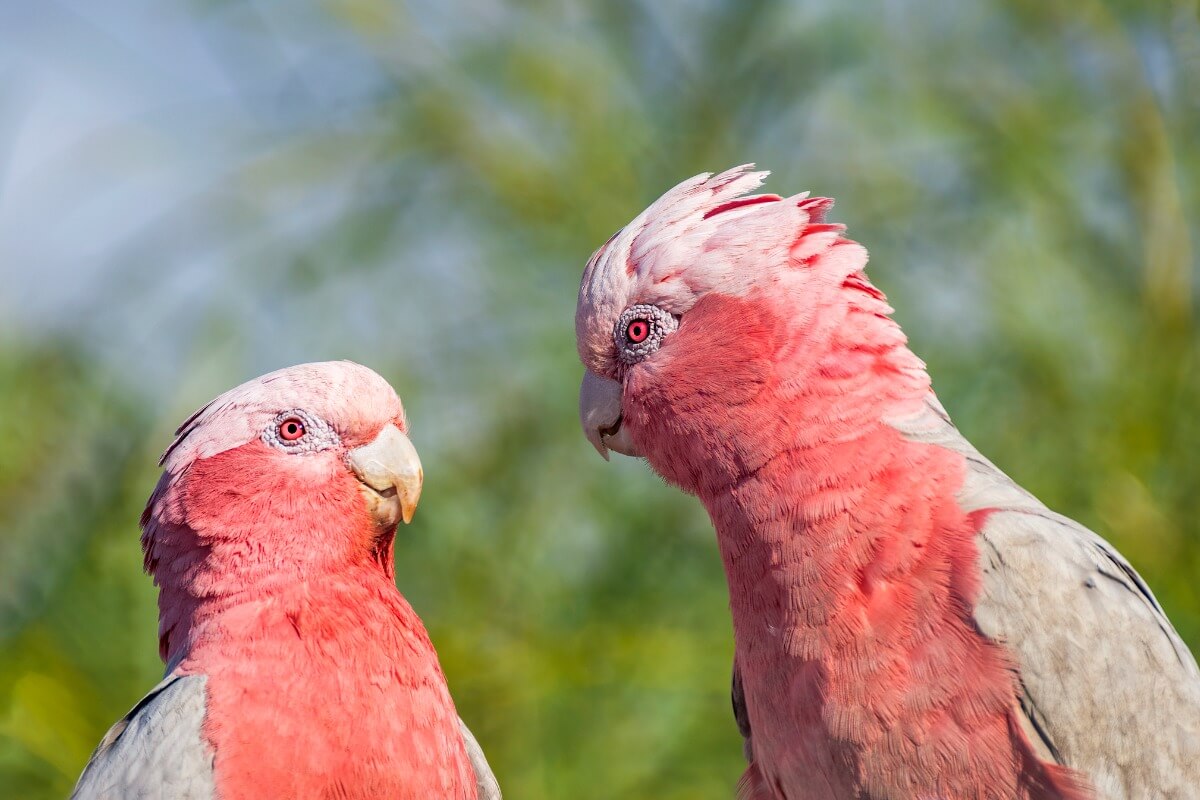Pink and Grey Cockatoo: Habitat and Characteristics

Did you know that there is a pink and grey cockatoo? Nature constantly amazes us with its color palette and this bird, exactly as its name implies, has vivid pink and gray hues. This parrot is the most common of all the cockatoos in Australia and one of the few native species that flourished after the European conquest.
“Galah” is the aboriginal name for these birds, and the name comes from Yuwaalaraay, the language spoken by the natives in what is now the state of New South Wales. Over time, this name was adapted to Australian English.
Interestingly, in Australian English, this word is also a slang term that means “clown” or “fool”, named after the pirouettes and funny behavior of these birds. Here you can learn more about this unique pink and grey cockatoo.
Where does the pink and grey cockatoo live?
There are several subspecies of this bird (Eolophus roseicapilla), also known as Galah, and the rose-breasted cockatoo. However, they’re all very similar and live all over Australia, even in city parks.
Most pink cockatoos spend their days sheltering in trees or bushes, but, when evening comes, they congregate in large noisy flocks. Experts say that it’s common to see them covering a tree almost completely. It’s also common to observe them foraging in the grasslands, while feeding on seeds.
In addition, observers have recorded sightings of this bird in a neighboring country of Australia: New Zealand. Whatever the case, experts estimate that there are only about 100 of these birds in total, and all living in the same area.
In some backyards
Many of these parrots can also be found in Australians’ backyards – and in other countries – as pets. The Galah is an excellent voice and sound impersonator, which makes it very popular as a pet, adding to its attractive colors and funny personality.
In the wild, these birds live for about 25 years, but, in captivity, they can live up to 80 years, according to the aforementioned portals. Like the rest of the parrot family, it’s a very long-lived bird.

Physical characteristics
This curious bird grows to around 36 centimeters (14 inches) and weighs between 270 and 350 grams (9.5 to 12 oz). It’s a small cockatoo, with a bright pink neck, chest — and under the wings. It has a pink feathered cephalic crest and its back, tail, and upper wings are pale gray.
Males and females look very similar in their plumage. However, to differentiate them, you just need to look at their eyes; males have dark brown or black eyes, while females have pink or red eyes.
How do pink and grey cockatoos behave?
They’re gregarious birds. These cockatoos live in large flocks of up to 1,000 birds – according to the Los Angeles Zoo – made up of pairs and small social groups, which congregate to feed and rest. When dusk comes, they do stunts before they go to sleep – flying quickly in and out of trees, swooping toward the ground, and screaming loudly.
In pink and grey cockatoos, a male and a female mate for life. For this reason, they spend most of their time in pairs, eating, cleaning and playing together. They’re very sociable and affectionate animals.
The couples return to the same nesting site each year and defend it from other pink and gray cockatoos or animals of different species. Once in the place of choice, they prepare the nest for the eggs, covering it with eucalyptus leaves. To communicate to the other birds that this home is occupied, they chew most of a branch near the nest.
Their feeding and reproduction
During courtship, the male raises his crest of feathers, moves his head from side to side, and struts along a branch towards the female, making soft sounds. Once copulation has taken place, the nests are made in the hollow of a tree, typically formed by termites. Both males and females incubate the eggs and feed the young.
The female lays 4-6 eggs, but unfortunately only half survive on average. When the young cockatoos are ready to leave their nest, the parents continue to care for them for about 6 to 8 weeks, but then they become independent.
As they feed on seeds, grasses, and herbs, it’s very common to see them on the ground, which makes them vulnerable to some predators, such as foxes. The advantage is that they feed in large flocks, where there are always several on guard who warn when danger approaches.
Subspecies of the pink and grey cockatoo
Studies say that there are still some discrepancies in relation to the status of the Galah genus and this can be found under the taxonomic criteria Eolophus and Cacatua. However, there are 3 subspecies of Eolophus roseicapilla, all very similar to each other. These are the following:
- Eolophus roseicapilla roseicapillus: This is the most common subspecies in poultry farming and in the wild in much of Australia. It’s an oriental bird that’s found to the east, northeast, south, and center of Australia and Tasmania, where it was introduced. It’s distinguished by having a whiter crest than its relatives and a pink ring around its brown or black eye.
- Eolophus roseicapilla assimilis or E. r. albiceps – Found throughout much of Western Australia, and distinguished by its paler body color and larger pink crest. The ring around its eye is almost white and its head is larger than that of its relatives.
- Eolophus roseicapilla kuhli – This subspecies is found in the northern part of Western Australia. It’s smaller and lighter in color than the other two subspecies. Its head is smaller, it has a pink crest, and the ring around its eyes is reddish in color.
Pink and grey cockatoo diseases
Cockatoos are robust and hardy birds. However, there are several infectious and non-infectious diseases to which Galahs and other cockatoos in general are susceptible. Some of these are as follows:
- Viral diseases: Avian influenza ( influenza virus A ) or flu in birds is extremely common in this group.
- Avian Polyomavirus – A double-stranded DNA virus that poses a major threat to caged birds.
- Parrot fever: This is known as psittacosis in the veterinary field. It’s transmissible to humans, and so it’s a zoonotic disease that must be taken into account at the health level.
- Bacterial infections.
- Candidiasis: Various types of fungi can cause yeast infections, especially Candida albicans. It’s also known as acid crop disease, as one of the first clinical signs of the affected bird is an injured crop with a whitish film.
What are their threats and conservation status?
Its current state of conservation isn’t a cause of concern, and its population is increasing. It’s estimated that there are around 5 million pink and grey cockatoos worldwide. They’re beneficial birds in their native ecosystems, stopping the spread of some weeds, but, in much of Australia, they’re viewed as a pest – due to their potential for destruction.
Cereal crops suffer great losses each year and frequently destroy the trees where they live. The most frequent causes of death in these birds are being run over by cars, cat attacks and gunfire by farmers, according to studies.

Pink and grey cockatoos have successfully adapted to suburban areas, due to the abundant water and seeds available in parks, farms, and backyards throughout Australia. However, urbanization and logging are on their heels, as the loss of large trees makes it difficult for them to find permanent nesting sites.
Did you know that there is a pink and grey cockatoo? Nature constantly amazes us with its color palette and this bird, exactly as its name implies, has vivid pink and gray hues. This parrot is the most common of all the cockatoos in Australia and one of the few native species that flourished after the European conquest.
“Galah” is the aboriginal name for these birds, and the name comes from Yuwaalaraay, the language spoken by the natives in what is now the state of New South Wales. Over time, this name was adapted to Australian English.
Interestingly, in Australian English, this word is also a slang term that means “clown” or “fool”, named after the pirouettes and funny behavior of these birds. Here you can learn more about this unique pink and grey cockatoo.
Where does the pink and grey cockatoo live?
There are several subspecies of this bird (Eolophus roseicapilla), also known as Galah, and the rose-breasted cockatoo. However, they’re all very similar and live all over Australia, even in city parks.
Most pink cockatoos spend their days sheltering in trees or bushes, but, when evening comes, they congregate in large noisy flocks. Experts say that it’s common to see them covering a tree almost completely. It’s also common to observe them foraging in the grasslands, while feeding on seeds.
In addition, observers have recorded sightings of this bird in a neighboring country of Australia: New Zealand. Whatever the case, experts estimate that there are only about 100 of these birds in total, and all living in the same area.
In some backyards
Many of these parrots can also be found in Australians’ backyards – and in other countries – as pets. The Galah is an excellent voice and sound impersonator, which makes it very popular as a pet, adding to its attractive colors and funny personality.
In the wild, these birds live for about 25 years, but, in captivity, they can live up to 80 years, according to the aforementioned portals. Like the rest of the parrot family, it’s a very long-lived bird.

Physical characteristics
This curious bird grows to around 36 centimeters (14 inches) and weighs between 270 and 350 grams (9.5 to 12 oz). It’s a small cockatoo, with a bright pink neck, chest — and under the wings. It has a pink feathered cephalic crest and its back, tail, and upper wings are pale gray.
Males and females look very similar in their plumage. However, to differentiate them, you just need to look at their eyes; males have dark brown or black eyes, while females have pink or red eyes.
How do pink and grey cockatoos behave?
They’re gregarious birds. These cockatoos live in large flocks of up to 1,000 birds – according to the Los Angeles Zoo – made up of pairs and small social groups, which congregate to feed and rest. When dusk comes, they do stunts before they go to sleep – flying quickly in and out of trees, swooping toward the ground, and screaming loudly.
In pink and grey cockatoos, a male and a female mate for life. For this reason, they spend most of their time in pairs, eating, cleaning and playing together. They’re very sociable and affectionate animals.
The couples return to the same nesting site each year and defend it from other pink and gray cockatoos or animals of different species. Once in the place of choice, they prepare the nest for the eggs, covering it with eucalyptus leaves. To communicate to the other birds that this home is occupied, they chew most of a branch near the nest.
Their feeding and reproduction
During courtship, the male raises his crest of feathers, moves his head from side to side, and struts along a branch towards the female, making soft sounds. Once copulation has taken place, the nests are made in the hollow of a tree, typically formed by termites. Both males and females incubate the eggs and feed the young.
The female lays 4-6 eggs, but unfortunately only half survive on average. When the young cockatoos are ready to leave their nest, the parents continue to care for them for about 6 to 8 weeks, but then they become independent.
As they feed on seeds, grasses, and herbs, it’s very common to see them on the ground, which makes them vulnerable to some predators, such as foxes. The advantage is that they feed in large flocks, where there are always several on guard who warn when danger approaches.
Subspecies of the pink and grey cockatoo
Studies say that there are still some discrepancies in relation to the status of the Galah genus and this can be found under the taxonomic criteria Eolophus and Cacatua. However, there are 3 subspecies of Eolophus roseicapilla, all very similar to each other. These are the following:
- Eolophus roseicapilla roseicapillus: This is the most common subspecies in poultry farming and in the wild in much of Australia. It’s an oriental bird that’s found to the east, northeast, south, and center of Australia and Tasmania, where it was introduced. It’s distinguished by having a whiter crest than its relatives and a pink ring around its brown or black eye.
- Eolophus roseicapilla assimilis or E. r. albiceps – Found throughout much of Western Australia, and distinguished by its paler body color and larger pink crest. The ring around its eye is almost white and its head is larger than that of its relatives.
- Eolophus roseicapilla kuhli – This subspecies is found in the northern part of Western Australia. It’s smaller and lighter in color than the other two subspecies. Its head is smaller, it has a pink crest, and the ring around its eyes is reddish in color.
Pink and grey cockatoo diseases
Cockatoos are robust and hardy birds. However, there are several infectious and non-infectious diseases to which Galahs and other cockatoos in general are susceptible. Some of these are as follows:
- Viral diseases: Avian influenza ( influenza virus A ) or flu in birds is extremely common in this group.
- Avian Polyomavirus – A double-stranded DNA virus that poses a major threat to caged birds.
- Parrot fever: This is known as psittacosis in the veterinary field. It’s transmissible to humans, and so it’s a zoonotic disease that must be taken into account at the health level.
- Bacterial infections.
- Candidiasis: Various types of fungi can cause yeast infections, especially Candida albicans. It’s also known as acid crop disease, as one of the first clinical signs of the affected bird is an injured crop with a whitish film.
What are their threats and conservation status?
Its current state of conservation isn’t a cause of concern, and its population is increasing. It’s estimated that there are around 5 million pink and grey cockatoos worldwide. They’re beneficial birds in their native ecosystems, stopping the spread of some weeds, but, in much of Australia, they’re viewed as a pest – due to their potential for destruction.
Cereal crops suffer great losses each year and frequently destroy the trees where they live. The most frequent causes of death in these birds are being run over by cars, cat attacks and gunfire by farmers, according to studies.

Pink and grey cockatoos have successfully adapted to suburban areas, due to the abundant water and seeds available in parks, farms, and backyards throughout Australia. However, urbanization and logging are on their heels, as the loss of large trees makes it difficult for them to find permanent nesting sites.
All cited sources were thoroughly reviewed by our team to ensure their quality, reliability, currency, and validity. The bibliography of this article was considered reliable and of academic or scientific accuracy.
Australasian Society of Zoo Keeping. (2021, 10 junio). Australian Society of Zoo Keeping – Professional Development & Resources. https://aszk.org.au/wp-content/uploads/2020/03/Birds.-Galah-2008CS.pdf
Backyard Buddies. (2020, 10 octubre). Galahs. https://backyardbuddies.org.au/backyard-buddies/galahs/
Idaho Falls. (s. f.). Idaho Falls, ID | Official Website. Recuperado 11 de junio de 2021, de https://www.idahofallsidaho.gov/DocumentCenter/View/5014/Rose-Breasted-Cockatoo
The digital encyclopedia of New Zealand birds. (s. f.). Galah | New Zealand Birds Online. New Zealand Birds Online. Recuperado 11 de junio de 2021, de http://nzbirdsonline.org.nz/species/galah
The Los Angeles Zoo and Botanical Gardens. (2021, 21 abril). Rose-Breasted Cockatoo (Galah). Los Angeles Zoo and Botanical Gardens (LA Zoo). https://www.lazoo.org/explore-your-zoo/our-animals/birds/cockatoo-rose-breasted/
This text is provided for informational purposes only and does not replace consultation with a professional. If in doubt, consult your specialist.








